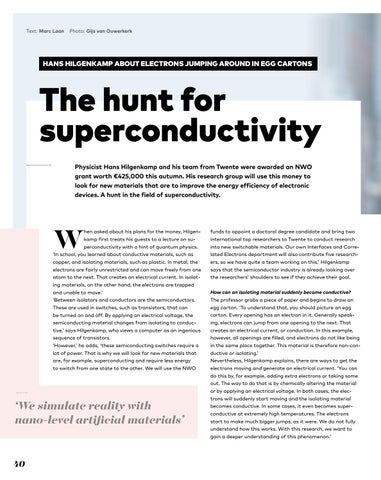Text: Marc Laan
Photo: Gijs van Ouwerkerk
HANS HILGENKAMP ABOUT ELECTRONS JUMPING AROUND IN EGG CARTONS
The hunt for superconductivity Physicist Hans Hilgenkamp and his team from Twente were awarded an NWO grant worth €425,000 this autumn. His research group will use this money to look for new materials that are to improve the energy efficiency of electronic devices. A hunt in the field of superconductivity.
W
hen asked about his plans for the money, Hilgen-
funds to appoint a doctoral degree candidate and bring two
kamp first treats his guests to a lecture on su-
international top researchers to Twente to conduct research
perconductivity with a hint of quantum physics.
into new switchable materials. Our own Interfaces and Corre-
‘In school, you learned about conductive materials, such as
lated Electrons department will also contribute five research-
copper, and isolating materials, such as plastic. In metal, the
ers, so we have quite a team working on this.’ Hilgenkamp
electrons are fairly unrestricted and can move freely from one
says that the semiconductor industry is already looking over
atom to the next. That creates an electrical current. In isolat-
the researchers’ shoulders to see if they achieve their goal.
ing materials, on the other hand, the electrons are trapped and unable to move.’
How can an isolating material suddenly become conductive?
‘Between isolators and conductors are the semiconductors.
The professor grabs a piece of paper and begins to draw an
These are used in switches, such as transistors, that can
egg carton. ‘To understand that, you should picture an egg
be turned on and off. By applying an electrical voltage, the
carton. Every opening has an electron in it. Generally speak-
semiconducting material changes from isolating to conduc-
ing, electrons can jump from one opening to the next. That
tive,’ says Hilgenkamp, who views a computer as an ingenious
creates an electrical current, or conduction. In this example,
sequence of transistors.
however, all openings are filled, and electrons do not like being
‘However,’ he adds, ‘these semiconducting switches require a
in the same place together. This material is therefore non-con-
lot of power. That is why we will look for new materials that
ductive or isolating.’
are, for example, superconducting and require less energy
Nevertheless, Hilgenkamp explains, there are ways to get the
to switch from one state to the other. We will use the NWO
electrons moving and generate an electrical current. ‘You can do this by, for example, adding extra electrons or taking some out. The way to do that is by chemically altering the material or by applying an electrical voltage. In both cases, the elec-
‘We simulate reality with nano-level artificial materials’
trons will suddenly start moving and the isolating material becomes conductive. In some cases, it even becomes superconductive at extremely high temperatures. The electrons start to make much bigger jumps, as it were. We do not fully understand how this works. With this research, we want to gain a deeper understanding of this phenomenon.’
40
